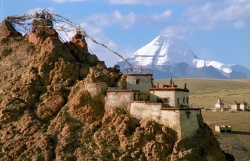Difference between revisions of "Drira Phuk"
(Created page with "The Drira Phuk monastery (also spelled Duraphuk) is a south facing monastery on the side of a steep, narrow valley near the base of the sheer, 6000 ft north face of Kailash. ...") |
|||
| Line 1: | Line 1: | ||
| − | The Drira Phuk monastery (also spelled Duraphuk) is a south facing monastery on the side of a steep, narrow valley near the base of the sheer, 6000 ft north face of Kailash. It is built around the cave of Drira Phuk and was renovated in the late 1980s. Despite the renovations, the monastery itself dates back to the 13th century. One enters a south facing main entrance into an open-air courtyard, used by pilgrims for tea and rest. From there, one proceeds to the dukhang main hall where the Drira Phuk cave is. The cave is consecrated to the first explorer and master to circumambulate Mt. Kailash, Gotshangpa. It is said that he was led to the cave by a dri (female yak) goddess named Senge Dongpa (the Lion Faced Celestial Angel) who came to his rescue when he was caught in a heavy rainfall after making a pilgrimage down to Lake Manasarovar. Thus the monastery's name means "cave of the female yak horn." At the rear of the cave is a new statue of Gotshangpa. Also, imprints from the dri's horn can be seen on the cave walls. The original was destroyed in the Cultural Revolution. | + | [[File:0265-hd.jpg|thumb|250px|]] |
| + | The [[Drira Phuk]] [[monastery]] (also spelled Duraphuk) is a {{Wiki|south}} facing [[monastery]] on the side of a steep, narrow valley near the base of the sheer, 6000 ft {{Wiki|north}} face of [[Kailash]]. It is built around the {{Wiki|cave}} of [[Drira Phuk]] and was renovated in the late 1980s. Despite the renovations, the [[monastery]] itself dates back to the 13th century. One enters a {{Wiki|south}} facing main entrance into an open-air courtyard, used by [[pilgrims]] for tea and rest. From there, one proceeds to the dukhang main hall where the [[Drira Phuk]] {{Wiki|cave}} is. The {{Wiki|cave}} is [[consecrated]] to the first explorer and [[master]] to circumambulate [[Mt. Kailash]], Gotshangpa. It is said that he was led to the {{Wiki|cave}} by a dri ({{Wiki|female}} yak) [[goddess]] named Senge Dongpa (the [[Lion]] Faced [[Celestial]] [[Angel]]) who came to his rescue when he was caught in a heavy rainfall after making a [[pilgrimage]] down to [[Lake Manasarovar]]. Thus the monastery's [[name]] means "{{Wiki|cave}} of the {{Wiki|female}} yak horn." At the rear of the {{Wiki|cave}} is a new statue of Gotshangpa. Also, imprints from the dri's horn can be seen on the {{Wiki|cave}} walls. The original was destroyed in the {{Wiki|Cultural Revolution}}. | ||
Latest revision as of 16:29, 15 September 2013
The Drira Phuk monastery (also spelled Duraphuk) is a south facing monastery on the side of a steep, narrow valley near the base of the sheer, 6000 ft north face of Kailash. It is built around the cave of Drira Phuk and was renovated in the late 1980s. Despite the renovations, the monastery itself dates back to the 13th century. One enters a south facing main entrance into an open-air courtyard, used by pilgrims for tea and rest. From there, one proceeds to the dukhang main hall where the Drira Phuk cave is. The cave is consecrated to the first explorer and master to circumambulate Mt. Kailash, Gotshangpa. It is said that he was led to the cave by a dri (female yak) goddess named Senge Dongpa (the Lion Faced Celestial Angel) who came to his rescue when he was caught in a heavy rainfall after making a pilgrimage down to Lake Manasarovar. Thus the monastery's name means "cave of the female yak horn." At the rear of the cave is a new statue of Gotshangpa. Also, imprints from the dri's horn can be seen on the cave walls. The original was destroyed in the Cultural Revolution.
Source
[www.colorado.edu/APS/landscapes/tibet/driraphuk.htm colorado.edu]
